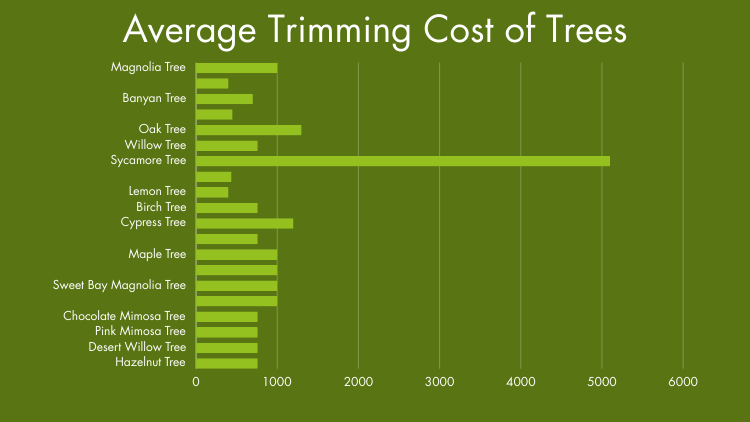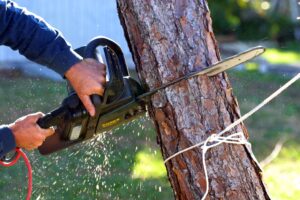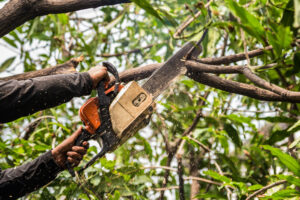A Comprehensive Guide of Tree Trimming Cost Calculator
Tree trimming is crucial for maintaining the health, appearance, and safety of your trees and property. Whether you’re dealing with a few branches near a power line or a massive oak that towers over your home, understanding the costs and what factors into them can help you budget and plan more effectively. This guide covers everything you need to know about tree trimming costs, from understanding the different pricing structures to detailed breakdowns of costs by tree size and species. Use our Tree Trimming Cost Calculator to get a personalized estimate tailored to your specific needs.
1. Understanding Tree Trimming Costs
Tree trimming costs can vary widely depending on a multitude of factors such as tree size, location, accessibility, and even the time of year. Most tree trimming services charge a flat rate per job rather than by the hour, though some may offer hourly rates for specific circumstances. Let’s dive deeper into these cost structures to better understand what you might expect when planning your tree trimming project.
Flat Rate vs. Hourly Rate
Flat rates are the most common pricing method for tree trimming services. This is because trimming a tree often involves complex logistics, specialized equipment, and a team of professionals. Charging by the hour can become unpredictable and expensive, especially if unforeseen challenges arise, such as difficult tree access or unexpected weather conditions.
- Flat Rates: Flat rates provide a set cost for the entire job, based on a pre-inspection of the tree and its surroundings. This rate includes labor, equipment, safety measures, and cleanup. Flat rates offer more predictability and peace of mind for homeowners.
- Hourly Rates: Hourly rates are less common but can be useful for smaller, simpler jobs or ongoing maintenance. However, due to the nature of tree trimming, hourly costs can add up quickly. On average, hourly rates for professional tree trimmers range from $50 to $80, while certified arborists may charge between $87 and $116 per hour.
Average Tree Trimming Costs by Size
The size and height of the tree are major determinants of trimming costs. Here’s a more detailed breakdown of what you can expect to pay based on tree size:
- Small Trees (10-20 feet): Cost ranges from $75 to $300. These trees are generally easier to handle because they are more accessible from the ground, often requiring only basic trimming tools like pole saws or pruning shears.
- Medium Trees (20-30 feet): Cost ranges from $150 to $450. At this height, the job may require ladders or climbing gear, as well as additional safety equipment. Medium-sized trees are comparable to a two-story house, and the job might need more workers for safety reasons.
- Large Trees (30-50 feet): Cost ranges from $150 to $800. Trees this size often require harnessing or even crane assistance to reach the uppermost branches safely. The job involves handling thicker branches, necessitating more powerful equipment like chainsaws.
- Extra-Large Trees (50-100 feet): Cost ranges from $300 to $1,800. These towering trees require bucket trucks or cranes to access the highest branches safely. The significant height increases the risk of falling branches, making professional handling essential.
2. Factors Influencing Tree Trimming Costs
Tree trimming costs are not one-size-fits-all. Several factors can significantly influence the price of your tree trimming project. Understanding these factors can help you better estimate costs and make informed decisions when hiring professionals.
Key Cost Factors
- Tree Size and Height: As detailed earlier, larger trees require more time, equipment, and manpower, leading to higher costs. The height of the tree determines the type of access equipment needed—ranging from simple ladders to cranes or bucket trucks.
- Tree Species: The species of the tree can affect the trimming cost due to differences in branch thickness, density, and tree structure. For example, oak trees are generally more expensive to trim than cherry trees because they have harder wood and a more complex structure.
- Location and Accessibility: Trees located near structures, fences, power lines, or in confined spaces can make the trimming process more complex and risky. Trimmers need to take extra precautions and use specialized equipment to avoid property damage, which can increase the cost.
- Health and Condition of the Tree: Diseased, dead, or damaged trees can be more dangerous to trim, requiring extra safety measures and possibly more time to complete the job. This can also drive up costs.
- Season and Timing: Trimming trees during off-peak seasons, such as late fall to early spring, can sometimes reduce costs due to lower demand. However, emergency trimming or trimming during active seasons (like spring and summer when growth is rapid) may incur higher fees.
- Debris Removal: Some services include debris removal in the overall cost, but others may charge extra for hauling away branches, leaves, and other waste. Be sure to clarify this when getting estimates.
- Emergency Services: Emergency tree trimming services, such as those required after a storm or when a tree poses an immediate danger, often come with premium pricing due to the urgency and potential risks involved.
3. Hourly Rates vs. Flat Rates: Which Is Better?
Choosing between hourly rates and flat rates depends largely on the scope of the work and your personal preferences for predictability versus potential cost savings.
Pros and Cons of Flat Rates:
- Pros:
- Predictability: You know the total cost upfront, which helps with budgeting.
- All-Inclusive: Typically includes all aspects of the job, from setup to cleanup.
- No Time Pressure: Workers are not rushed by the hour, allowing for thorough and safe job completion.
- Cons:
- Potentially Higher Cost: For smaller jobs, you might pay more than if the job were priced hourly.
Pros and Cons of Hourly Rates:
- Pros:
- Potential Savings on Small Jobs: If the job is simple and quick, you might save money compared to a flat rate.
- Flexibility: Hourly rates can be advantageous for ongoing maintenance or smaller trimming tasks.
- Cons:
- Unpredictability: Costs can escalate if unexpected challenges arise, such as additional debris or difficult access.
- Pressure to Finish Quickly: Workers may feel pressured to complete the job quickly, which could compromise quality or safety.
4. DIY vs. Professional Tree Trimming
While some homeowners may consider trimming their own trees to save money, it’s important to weigh the risks and potential costs involved in DIY tree trimming.
DIY Tree Trimming: What You Need to Know
Equipment Costs:
- Basic Safety Gear: A hard hat, safety goggles, work gloves, and steel-toe boots are essential for personal safety. These items can cost around $155.
- Additional Safety Equipment: For more complex jobs requiring a chainsaw, you’ll need hearing protection and chainsaw chaps, which add about $96 to the cost.
- Climbing Equipment: An arborist climbing rope and harness will be necessary for higher branches, costing approximately $82.
- Cutting Tools: Essential tools include a handsaw, pruning shears, loppers, and possibly renting a chainsaw and polesaw, totaling around $177.
- Debris Removal: A wheelbarrow to haul away debris costs about $90.
Total DIY Cost Estimate: Around $600 for basic equipment, not including ongoing maintenance or replacement costs for tools.
Risks and Considerations:
- Safety Hazards: Tree trimming is dangerous, especially for large trees or those near power lines. Falls, cuts, and other injuries are common risks.
- Potential Damage: DIY trimming can lead to unintended damage to the tree, surrounding property, or yourself, which could end up costing more than hiring a professional.
- Time and Effort: Tree trimming can be time-consuming, physically demanding, and requires a fair amount of expertise to do correctly.
Why Hiring Professionals Is Often the Best Choice
Expertise and Experience: Professional trimmers and arborists have the training, experience, and equipment to handle trees safely and effectively, ensuring the job is done right.
Insurance and Liability: Professionals are insured, which protects you from liability if something goes wrong during the trimming process.
Time Savings: Hiring professionals saves you the time and effort of doing it yourself, allowing you to focus on other priorities.
Long-Term Tree Health: Professionals know how to trim trees in a way that promotes health and longevity, reducing the risk of disease or damage.

5. Tree Trimming Cost by Tree Species
The species of tree plays a significant role in determining trimming costs. Different species have unique characteristics that can make them easier or more difficult to trim. Below is a detailed chart showing trimming costs for various tree species:
| Tree Type | Trimming Cost Range | Notes |
|---|---|---|
| Magnolia Tree | $75 - $1,000 | Pruning often needed to maintain shape. |
| Cherry Tree | $100 - $400 | Smaller size makes them easier to manage. |
| Banyan Tree | $315 - $700 | Complex structure with thick branches. |
| Dogwood Tree | $75 - $450 | Requires delicate trimming to avoid damage. |
| Oak Tree | $850 - $1,300 | Hardwood and size increase trimming difficulty. |
| Willow Tree | $200 - $760 | Flexible branches, but large size adds cost. |
Sycamore Tree | $750 - $5,100 | Very large; often requires crane assistance. |
| Mulberry Tree | $125 - $437 | Fast-growing, needs regular maintenance. |
| Lemon Tree | $100 - $400 | Typically smaller, easier to trim. |
| Birch Tree | $200 - $760 | Requires careful pruning to prevent disease. |
| Cypress Tree | $150 - $1,200 | Can grow very tall; often in dense clusters. |
| Ash Tree | $200 - $760 | Vulnerable to pests; careful trimming needed. |
| Maple Tree | $400 - $1,000 | Dense branches; often needs reduction pruning. |
| Pink Magnolia Tree | $75 - $1,000 | Similar care to standard magnolia. |
| Southern Magnolia Tree | $75 - $1,000 | Large leaves and flowers add complexity. |
| Chocolate Mimosa Tree | $200 - $760 | Unique branching patterns; delicate trimming. |
| Desert Willow Tree | $200 - $760 | Drought-resistant, lighter trimming needed. |
| Hazelnut Tree | $200 - $760 | Moderate size; manageable but needs care. |
Key Considerations:
- Species Complexity: Some species, like oaks and sycamores, have complex branching and dense wood, making them more challenging to trim.
- Growth Patterns: Fast-growing trees like mulberries may require more frequent trimming to keep them manageable.
- Disease and Pest Vulnerability: Species like ash and birch are susceptible to certain pests and diseases, necessitating careful and informed trimming practices.
6. Using a Tree Trimming Cost Calculator
A Tree Trimming Cost Calculator can be an invaluable tool for estimating costs based on your specific needs. These calculators take into account various factors, including tree height, species, location, and additional services, providing a more accurate cost estimate.
How to Use the Calculator:
- Tree Height: Enter the approximate height of your tree. This helps determine the equipment needed and the job’s complexity.
- Species Selection: Choose the species of your tree from a dropdown menu. Knowing the species allows the calculator to adjust for factors like branch density and wood hardness.
- Location Challenges: Indicate any nearby obstacles, such as power lines, buildings, or fences. These increase the complexity and cost of the job.
- Additional Services: Options such as stump removal, debris hauling, and emergency service can be selected to provide a comprehensive estimate.
- Emergency Trimming: If the trimming is urgent, such as after storm damage, check the emergency service option to factor in the premium costs associated with urgent care.
- Access Considerations: Specify whether the tree is easily accessible or if special equipment like cranes or bucket trucks will be needed.
Example Calculation Fields:
- Tree Height: Input (e.g., 40 feet)
- Species: Select (e.g., Oak)
- Obstacles: Check applicable (e.g., near power lines)
- Emergency Service: Yes/No
- Debris Removal: Yes/No
7. Hiring the Right Tree Trimming Service
Hiring the right tree trimming service can make a significant difference in both the cost and quality of the job. Here are some key factors to consider when selecting a tree trimming service:
Certification and Insurance
- Certified Arborists: Look for professionals certified by reputable organizations such as the International Society of Arboriculture (ISA). Certified arborists have extensive knowledge of tree care and are trained in the latest techniques for trimming, pruning, and disease management.
- Insurance Coverage: Ensure that the company carries liability insurance to cover any potential damage to your property and workers' compensation to protect their employees. This protects you from being held liable for accidents or injuries that occur on your property.
Getting Estimates
- Request Multiple Quotes: To ensure competitive pricing, get at least three quotes from different companies. Be wary of prices that seem too low, as they may indicate a lack of experience, inadequate insurance, or subpar equipment.
- Detailed Written Estimates: Ask for a detailed written estimate that includes all aspects of the job, such as labor, equipment, cleanup, and any additional services like debris removal. This helps prevent unexpected costs later on.
Check Reviews and References
- Online Reviews: Look at online reviews on platforms like Google, Yelp, or the Better Business Bureau to gauge the company’s reputation and quality of service.
- Ask for References: A reputable tree trimming service should be able to provide references from satisfied customers. Contact these references to ask about their experience with the company, including reliability, professionalism, and overall satisfaction.
Key Questions to Ask:
- What’s Included in the Cost? Ensure that the estimate includes all necessary services, such as cleanup and debris removal.
- How Will You Protect My Property? Ask about the steps the company will take to protect your home, garden, and other structures during the trimming process.
- What Safety Measures Are in Place? Inquire about the safety protocols the crew will follow, especially if the job involves large or difficult-to-reach trees.
8. Tree Trimming Safety Tips
Tree trimming is a hazardous activity that requires proper training, equipment, and safety measures. Whether you’re hiring a professional or considering a DIY approach, safety should always be a top priority.
Professional Safety Standards
- Safety Gear: Professional tree trimmers use industry-standard safety gear, including helmets, gloves, goggles, and harnesses. For jobs involving chainsaws, additional gear such as ear protection and chainsaw chaps is also used.
- Rigging and Roping: For tall trees, professionals use rigging and roping techniques to safely lower cut branches, preventing damage to property and reducing the risk of injury.
- Cranes and Bucket Trucks: When trimming large or difficult-to-reach trees, professionals may use cranes or bucket trucks to safely access high branches. This equipment requires specialized training and certification.
DIY Safety Tips
If you decide to trim smaller trees yourself, follow these safety tips:
- Inspect Equipment: Regularly check your tools for wear and tear, and ensure they are in good working condition before starting any trimming job.
- Use Proper Techniques: Learn and use proper cutting techniques to avoid kickback and other common hazards associated with chainsaws and other cutting tools.
- Avoid Power Lines: Never attempt to trim trees near power lines yourself. Always call a professional, as this work requires special training and equipment.
- Stay Grounded: If your trimming job requires a ladder or climbing, consider hiring a professional. Falls are one of the most common causes of injury in tree trimming.
- Be Aware of Your Surroundings: Always be mindful of your surroundings, including other people, pets, and structures, to avoid accidents or injuries.
Conclusion
Tree trimming is an important aspect of maintaining the health, safety, and beauty of your trees and property. By understanding the costs involved, you can make informed decisions about when and how to trim your trees. Whether you opt for a professional service or decide to tackle smaller jobs yourself, always prioritize safety and quality. Use our Tree Trimming Cost Calculator to get an accurate estimate for your specific needs and ensure you hire certified, insured professionals for the job. Taking these steps will help keep your trees healthy and your property safe for years to come.
For a quick and accurate estimate, try our Tree Trimming Cost Calculator now, and take the first step towards a well-maintained landscape!




